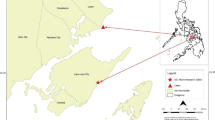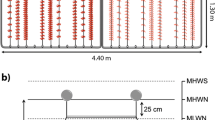Abstract
Hypnea musciformis is the only species so far exploited in Brazil as raw material for the production of k-carrageenan. Due to the erratic production in space and time, increasing harvest and transportation costs, experiments have been performed in order to assess the viability of H. musciformis mariculture.
In nature the species occurs as an epiphyte, and so mariculture using artificial substrates that simulated the natural host of the species was tried. These substrates were attached, at regular intervals, to linear ropes. In the sea, these ropes were stretched between cement blocks.
Seeding occurs naturally, by means of spores, or detached pieces of H. musciformis scattered in the water column that get entangled on the ropes. The best yields (0.54 wet kg m−1 month−1) were obtained with unthreaded rope substrates maintained in a vertical position by small rafts. Production is highest in the first 18 m off the rocky shore (0–2.1 m deep), at the highest substrate density utilized (10 m−1), 2–3 months after installing the ropes in seawater. The main factor controlling seasonal production is water movement.
Similar content being viewed by others
References
Berchez, F. A. S. & E. C. de Oliveira, 1990. Maricultural Assays with the carrageenophyte Hypnea musciformis (Rhodophyta, Gigartinales) in S. Paulo, Brazil. In E. C. Oliveira & I. Kautsky (eds), Cultivation of Seaweeds in Latin America, Univ. S. Paulo, Sao Paulo: 89–94.
Berchez, F. A. S., R. T. L. Pereira & H. L. A. Marques, 1989. Influênca da predação na maricultura de Hypnea musciformis (Rhodophyta, Gigartinales). Insula, Florianopolis, 19: 71–82.
Doty, M. S., 1987. The production and use of Eucheuma. In: M. S. Doty, J. F. Caddy & B. Santelices (eds.) Case studies of seven commercial seaweed resources. FAO Fish. Tech. Paper 281, Re: 123–164.
Druehl, L. D., 1988. Cultivated edible kelp. In C. A. Lembi & J. Waaland (eds), Algae and Human Affairs. Cambridge University Press, Cambridge: 119–134.
Meter, J. & W. Wasserman, 1974. Applied linear statistical models: regression analysis of variance and experimental design. Richard D. Irwin, Homewood, 872 pp.
Oliveira, E. C. & F. A. S. Berchez, 1987. Ensayos sobre el cultivo del alga roja Hypnea musciformis (Rhodophyta, Gigartinales) en Sao Paulo, Brasil. In J. A. J. Verreth, M. Carillo, S. Zanuy & A. Huisman (eds), Proc. Taller de trabajo sobre acuicultura en America Latina. Pudoc, Wageningen: 399–409.
Author information
Authors and Affiliations
Rights and permissions
About this article
Cite this article
Berchez, F.A.S., Pereira, R.T.L. & Kamiya, N.F. Culture of Hypnea musciformis (Rhodophyta, Gigartinales) on artificial substrates attached to linear ropes. Hydrobiologia 260, 415–420 (1993). https://doi.org/10.1007/BF00049050
Issue Date:
DOI: https://doi.org/10.1007/BF00049050




